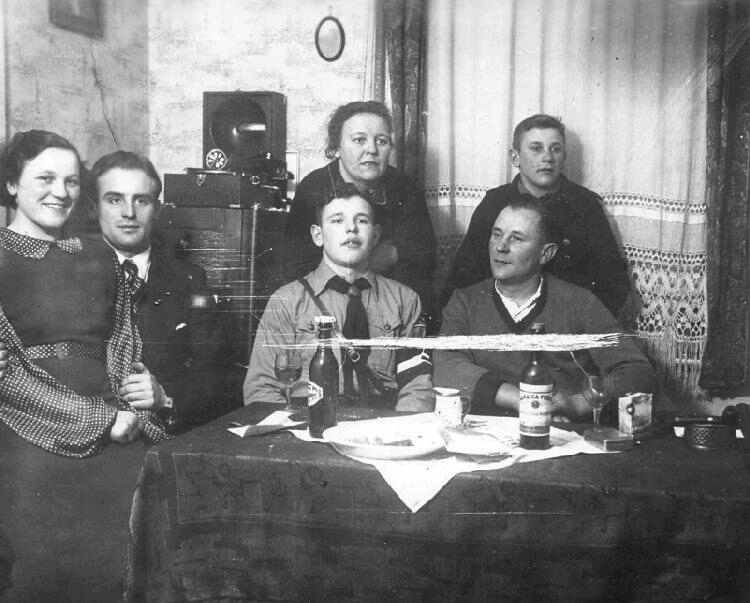
German Family Celebration (late-1930s)

Figure 1.-- This is a very interesting family image taken in the living room of what looks like a lower-middle class family. Unfortunately there is no inscription on the back identifying the family or dating the image. Even so, it illustrates some very important trends in Germany at the time. We believe the snap shot was tken in the late 1930s, although the early 40s is possible. The family consists of a mother and father with two teenage sons--both Hitler Youth boys.
|
|
This is a very interesting family image taken in the living room of what looks like a lower-middle class family. Unfortunately there is no inscription on the back identifying the family or dating the image. Even so, it illustrates some very important trends in Germany at the time. We believe the snap shot was tken in the late 1930s, although the early 40s is possible. The family consists of a mother and father with two teenage sons--both Hitler Youth boys. The couple to the left may be an older son and his wife. Note the phonograph and rafio in the background. This was the family's livingroom and the phonograph and radio were a very important part of it. The sparseness of the room suggests a lower-middle class or working-class family. They seem to be having some kind of celebration. As the one boy is at the center of the photograph, perhaps it is his birthday. The fact that he has a HJ armband on, suggests he is dressed up a bit. Note that both boys are wearing their HJ uniforms, even for an intimate family celebration. I'm not sure what the bottles are on the table, but it looks like some kind of little snack for the celebration. The boys wearing their uniforms suggests to us that this was a pro-NAZI family. This illustrates a very important trend in Germany during the 1930s wjich help to make the NAZIs popular. One goal of Hitler and the NAZIs was to create ein Volk (one united people). And the NAZIs did create opportunities for many working-class and lower-middle class boyswith good records in the HJ. This was accomplished in various ways. Secondary schools and universities were opened up to boys from families with modest means. This was accomplished by reducing the academic standards and making places by reducing places for girls and excluding Jews as well as boys from less poltically reliable families. Jobs were also created for reliable NAZIs in the civil service and other public servants like teachers. Children's experiences in the HJ and subsequently in the Reich Labor Service (RAD) and military all were designed to have a leveling affect and reduce class barriers. As a result, the German thar emerged from World War II was a much less class-statified society than the Germany the NAZIs seized from the Weimar Republic.
HBC

Navigate the Boys' Historical Clothing Web Site:
[Introduction]
[Activities]
[Biographies]
[Chronology]
[Clothing styles]
[Countries]
[Girls]
[Bibliographies]
[Contributions]
[Essays]
[FAQs]
[Glossaries]
[Images]
[Links]
[Registration]
[Tools]
[Boys' Clothing Home]
Navigate the Boys' Historical Clothing Belgin pages:
[Return to the Main German 1930s family page]
[Return to the Main German page]
[German choirs]
[German movies]
[German royals]
[German schools]
[German military schools]
[German youth groups]
[String ties]
[H-bar shorts]
Created: 8:18 PM 2/25/2008
Last updated: 8:18 PM 2/25/2008



